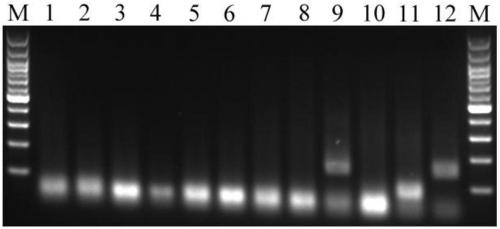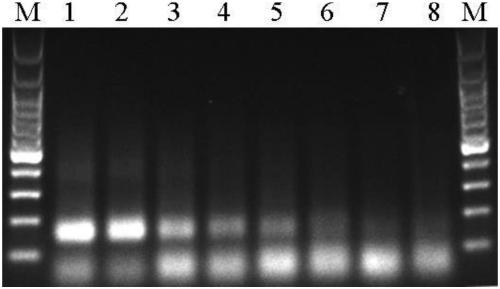Method of applying RPA technology for detecting suginami root-knot nematode, RPA primer and kit
A root-knot nematode and technical detection technology, which is applied in the direction of biochemical equipment and methods, microbial measurement/inspection, etc., can solve the problems of difficult application of rapid diagnosis, high professional quality requirements, and long time consumption, so as to protect the safety of agricultural and forestry production in our country , high sensitivity, short time-consuming effect
- Summary
- Abstract
- Description
- Claims
- Application Information
AI Technical Summary
Problems solved by technology
Method used
Image
Examples
Embodiment 1
[0040] Embodiment 1, DNA extraction method
[0041] Pick a single nematode and put it into a 200 μL PCR tube [with 10 μL double-distilled water and 5 μL 10×PCR buffer (without Mg2+)], place it in liquid nitrogen for 1 min (or place it at -70 degrees for 0.5 h), and immediately take it out for 85 ℃ heating 2min. Then add 1 μL of 1 mg / mL proteinase K to the PCR tube, heat at 56°C for 30 minutes, and heat at 95°C for 10 minutes, and microcentrifuge the PCR tube in a microcentrifuge to obtain a DNA template.
Embodiment 2
[0042] Embodiment 2, RPA detection method
[0043] RPA React uses Basic kit, the total reaction system is 50 μL, first add 29.5 μL of reaction buffer, 2.4 μL of 10 μM upstream and downstream primers, 1 μL of DNA template, and ddH in a 0.2 ml PCR tube 2 O 12.2 μL, after mixing, add to the RPA reaction tube containing RPA freeze-dried enzyme powder and mix evenly, add 2.5 μL of 280mM MgAc solution, place the RPA reaction tube in a metal bath, and react at 38°C for 30 minutes, the reaction product detected using gel electrophoresis. Electrophoresis: 5μL RPA product was separated by 10g / L agarose gel electrophoresis, stained with DNA dye and visualized under the ultraviolet gel imaging system. If a specific fragment with a size of 145bp appeared, it was root-knot nematode. The sample without a band at 145bp is not M. suginifera.
Embodiment 3
[0044] Embodiment 3, accuracy and reliability test---the specific amplification of root-knot nematode suginami
[0045] Using the extraction method of Example 1 and the RPA detection method of Example 2, DNA was extracted from the root-knot nematode population in Table 1 respectively, and RPA detection was carried out with DNA as a template. As a result, only root-knot nematode suginami was specifically amplified products, other root-knot nematode populations had no bands. partial results such as figure 1 As shown, each lane is respectively: M: DL100 molecular marker (its bands are 1500bp, 1000bp, 900bp, 800bp, 700bp, 600bp, 500bp, 400bp, 300bp, 200bp, 100bp from top to bottom); 1: Apple Root-knot nematode strain M1; 2: Root-knot nematode strain C1 of camellia; 3: Root-knot nematode strain MIYN1; 4: Root-knot nematode strain MHSD1; 5: Root-knot nematode MAJS2; 6: Root-knot nematode java Nematode MJFJ1; 7: Meloidogyne elegans MEHN2; 8: Meloidogyne hispanica MSHM1; 9: Meloidog...
PUM
 Login to View More
Login to View More Abstract
Description
Claims
Application Information
 Login to View More
Login to View More - R&D
- Intellectual Property
- Life Sciences
- Materials
- Tech Scout
- Unparalleled Data Quality
- Higher Quality Content
- 60% Fewer Hallucinations
Browse by: Latest US Patents, China's latest patents, Technical Efficacy Thesaurus, Application Domain, Technology Topic, Popular Technical Reports.
© 2025 PatSnap. All rights reserved.Legal|Privacy policy|Modern Slavery Act Transparency Statement|Sitemap|About US| Contact US: help@patsnap.com



